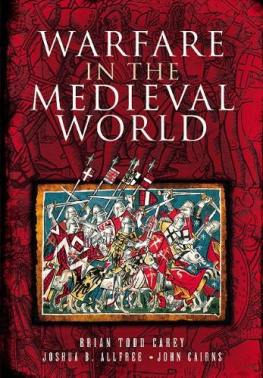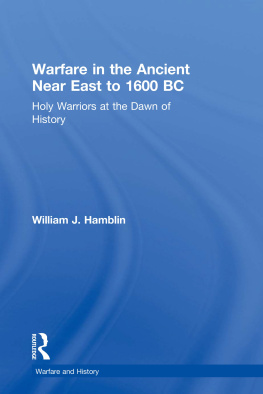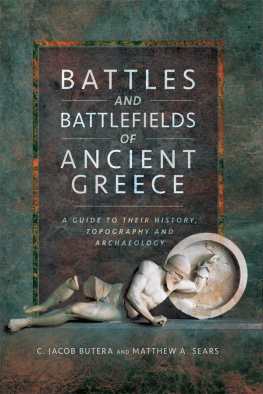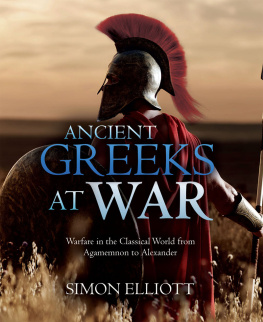Copyright
First published in Great Britain in 2005 by Pen & Sword Military
Digital Edition by Pen & Sword Digital 2011
Copyright Brian Todd Carey, Joshua B. Allfree and John Cairns, 2005, 2011
ISBN 978 1 84884 630 2
The right of Brian Todd Carey, Joshua B. Allfree and John Cairns to be identified as Authors of the Work has been asserted by them in accordance with the Copyright, Designs and Patents Act 1988.
A CIP catalogue record for this book is available from the British Library
All rights reserved. No part of this book may be reproduced or transmitted in any form or by any means, electronic or mechanical including photocopying, recording or by any information storage and retrieval system, without permission from the Publisher in writing.
Pen & Sword Books Ltd incorporates the Imprints of Pen & Sword Aviation, Pen & Sword Maritime, Pen & Sword Military, Wharncliffe Local History, Pen & Sword Select, Pen and Sword Military Classics and Leo Cooper.
For a complete list of Pen & Sword titles, please contact
Pen & Sword Books Limited
47 Church Street, Barnsley, South Yorkshire, S70 2AS, England
E-mail:
Website: www.pen-and-sword.co.uk
Glossary of Military Terms
Glossary of Military Terms
Agema: (4th century bce ) An elite 1,000-man Macedonian battalion of heavy infantry phalangites , part of the 3,000 strong Hypaspists or Shield Bearers who made up the kings infantry guard. Because of their discipline and loyalty, the Hypaspists were often placed between the phalanx and the elite Macedonian heavy cavalry, entrusted with filling the inevitable gap that appeared when heavy infantry and cavalry operated together in offensive action.
ala , pl. alae : (1st3rd centuries ce ) A cavalry unit of the Roman army and allied auxiliaries during the imperial period. Caesar Augustus made a regiment of 120 cavalrymen organic to each legion during the 1st century ce .
alae milliariae : (1st3rd centuries ce ) Auxiliary cavalry units numbering 8001,000 men who supported the Roman legion. These units date from the reign of Nero (d. 68 ce ).
aquilifer : (3rd1st centuries bce ) A Roman standard-bearer who carried the legions standard ( aquila ), a gold statuette of an eagle. This standard was very important to the legionaries who fought to bring their legion honour, and to emperors who went to great lengths to recover the standard if it was lost in battle.
articulation (tactical): A military term describing the offensive capability of troops. Unarticulated troops usually lacked the drill and discipline to march and fight in close order, and therefore usually fought in static, defensive formations. Well-articulated troops were capable of offensive action in close-order combat.
aspis , pl. aspides : (7th4th centuries bce ) A round wooden concave shield used by Greek hoplites in the phalanx. It was nearly 3 feet in diameter and weighed over 15 pounds, and was utilized in combat by holding a central grip behind the central boss. The round shield remained locked on the forearm with its weight being borne by the left shoulder. It was usually used in conjunction with a thrusting spear or short thrusting or slashing sword ( kopis ).
auxiliaries: (1st century bce 3rd century ce ) Non-citizen troops recruited to serve as valuable extra manpower for the Roman army, as well as in specialized tactical roles such as cavalry and light infantry. They were organized into cohorts and alae .
barbarization: The infiltration of non-Roman peoples (typically Germanic tribes) into Romes territory and political/military institutions, the crippling effects of which plagued the later years of the Roman Empire. It should be noted, however, that this was due as much to Roman policy as to the efforts of the Germanic tribes. Barbarization changed the concept of Roman citizenship, resulting in a weakening of the social, cultural and political foundations of the empire. After the defeat of the eastern Roman army at Adrianople in 378 ce , the Emperor Theodosius started the policy of accepting whole barbarian tribes into military service. Whole tribes would enter into Roman service under their own leaders. The barbarians would not follow Roman training and discipline.
barding: A protective covering for mounts. Barding could be of felt or leather or even form-fitted iron, and was designed to balance protection with mobility. Although horses were most often barded, camels and even elephants could be covered for war.
baritus : A Germanic war cry. Indo-European tribes often developed distinctive war cries when entering combat. The Roman army later adopted these battle cries after its barbarization.
bentwood technologies: (early 2nd millennium bce ) A woodworking technique which allowed for the construction of the spoked wheel with a rim of curved felloes, and the manufacture of lightweight chariot bodies. These new-style chariots revolutionized combat in north Africa during the New Kingdom period by creating for the first time a fast, manoeuvrable machine, one that could be used as a firing platform for composite-bow-wielding archers.
bow (self- and composite): The self-bow was a bow made of a single piece of wood. The first bows in human history were self-bows. Perhaps the most famous self-bow is the English longbow. The composite bow was a recurve bow constructed of wood, horn and tendons from oxen, carefully laminated together to create a bow of superior strength, range and impact power. Composite bows were first used by steppe peoples from horseback, and by civilizations from chariots.
bucellarii : (4th6th centuries ce ) Units of armed retainers of Byzantine nobles who took an additional oath of fealty to the Byzantine emperors. They usually consisted of very high quality cavalry.
cataphracts : (7th century bce 15th century ce ) Chain- or scale-mailed heavy cavalrymen from the Near East who employed the two-handed kontos in shock combat. This kind of close-order heavy cavalry originated in Persia in the 7th century bce and became the signature tactical system for later civilizations from that region (Persians, Parthians, Romans and Byzantines).
centurion: (1st century bce 3rd century ce ) A professional class of Roman officers who served for long periods of time (sometimes as long as twenty-five years) and provided the backbone of experience for the Roman army. There were sixty centurions per legion and each commanded a century of 6080 men.
century: (4th century bce 3rd century ce ) The basic subunit of the Roman legion, consisting of between 60 and 80 legionaries. The century was commanded by a centurion and was eventually made up of ten contubernia (groups of eight men who shared a tent and messed together).
chariotry: A term used by historians to indicate a force of chariots.
clibanarii : Heavily armoured cavalry in the Roman and Byzantine armies. These lancers and mounts were protected by composite chain- and scale-mail armour. As the Roman Empire wore on, these units formed an increasingly higher proportion of Roman cavalry and would become the dominant tactical system of the later Byzantine Empire.
cohort: (2nd century bce 3rd century ce ) This term originally applied to troops allied to Rome in the early republic, but became the basic manoeuvre unit of the Roman army by the end of the second century bce , creating the cohortal legion. It normally consisted of 480 legionaries in six 80-man centuries.
cohortes equitatae : Mixed auxiliary infantry and cavalry units numbering 8001,000 men who supported the Roman legion. These units date from the reign of Nero
(d. 68 ce ).
comitatenses : (4th6th centuries ce ) Units of the late Roman and early Byzantine field army that comprised mixed regular and barbarian regiments not specifically tied to frontier provinces. They often supported limitanei and bucellarii on campaign.
Next page







